#osmosis jones out of the body experience
Explore tagged Tumblr posts
Text

Happy 32nd Birthday, Miley Cyrus!
#miley cyrus#miley stewart#hannah montana#hannah montana the movie#bolt#penny forrester#christine kolchuck#osmosis jones 2011#osmosis jones out of the body experience#osmosis jones vs. the future#osmosis jones hector and travis get busted#molly morris#so undercover#happy birthday
22 notes
·
View notes
Text
Is it possible Elias Hodge was under mind control?
We now know the company he works for has been researching/experimenting with mind control. He is a junior researcher recently out of college working for Gobstopper Industries.
(Side note: Does Gobstopper Industries actually make Gobstoppers? Gobstoppers are a hard candy made by Nestlé. Nestlé is one of the biggest companies in the world and has done some of the shadiest things in its history.
Im curious if he works at THAT Gobstopper. Cause that would mean making mind controlling candy, right?)
In Mentopolis, the DA and higher brain functions hide a lot of information from the rest of the citizens. I mean, heck, they are hiding the fact that Elias is about to die!
So heres my question/theory.
Could Elias have been unwittingly apart of the mind control testing. Having eaten some candy. And in the candy was something that made its way to the brain and now as full control of the council.
In Osmosis Jones the pill was able to go wherever he wanted in the body. Maybe its the same for the Mind Control agent.
Maybe Mind Control is trying to shut down the brain from reacting because it keeps an internal check on its hosts. Making sure it never deviates from Big Wig orders. Maybe it has a contingency in place to let the host die or kill it from within if something ever happened.
I bet its up to the PIs to find this mind control bug, kill it, and find a way to save Elias before he hits the ground. (Some people have survived falling from planes with no parachute. Maybe its a matter of going limp or something?)
Anyways, thats my theory. What do y'all think?
#elias hodge#dimension 20#dimension 20 mentopolis#mentopolis#Mentopolis theory#dimension 20 theory#mentopolis spoilers#dimension 20 spoilers
105 notes
·
View notes
Photo
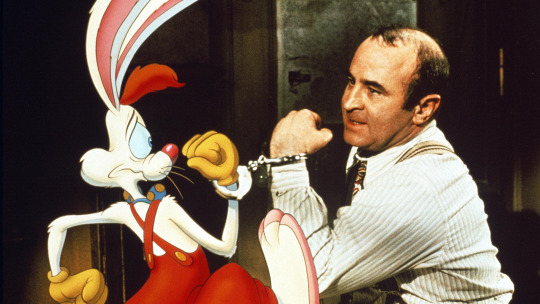
Blurring the Line.
As a new Space Jam film beams down to Earth, Kambole Campbell argues that a commitment to silliness and a sincere love for the medium is what it takes to make a great live-action/animation hybrid.
The live-action and animation hybrid movie is something of a dicey prospect. It’s tricky to create believable interaction between what’s real and what’s drawn, puppeteered or rendered—and blending the live and the animated has so far resulted in wild swings in quality. It is a highly specific and technically demanding niche, one with only a select few major hits, though plenty of cult oddities. So what makes a good live-action/animation hybrid?
To borrow words from Hayao Miyazaki, “live action is becoming part of that whole soup called animation”. Characters distinct from the humans they interact with, but rendered as though they were real creatures (or ghosts), are everywhere lately; in Paddington, in Scooby Doo, in David Lowery’s (wonderful) update of Pete’s Dragon.
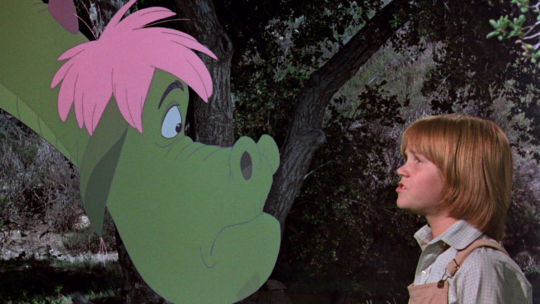
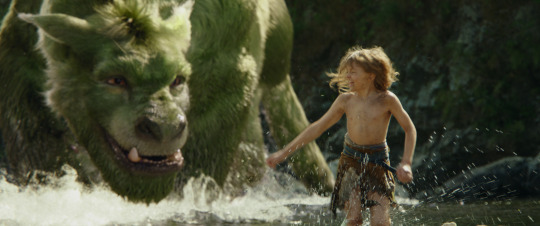
The original ‘Pete’s Dragon’ (1977) alongside the 2016 remake.
Lowery’s dragon is realized with highly realistic lighting and visual-effects work. By comparison, the cartoon-like characters in the 1977 Pete’s Dragon—along with other films listed in Louise’s handy compendium of Disney’s live-action animation—are far more exaggerated. That said, there’s still the occasional holdout for the classical version of these crossovers: this year’s Tom and Jerry replicating the look of 2D through 3D/CGI animation, specifically harkens back to the shorts of the 1940s and ’50s.
One type of live-action/animation hybrid focuses on seamless immersion, the other is interested in exploring the seams themselves. Elf (2003) uses the aberration of stop-motion animals to represent the eponymous character as a fish out of water. Ninjababy, a Letterboxd favorite from this year’s SXSW Festival, employs an animated doodle as a representation of the protagonist’s state of mind while she processes her unplanned pregnancy.
Meanwhile, every Muppets film ever literally tears at the seams until we’re in stitches, but, for the sake of simplicity, puppets are not invited to this particular party. What we are concerned with here is the overlap between hand-drawn animation and live-action scenes (with honorable mentions of equally valid stop-motion work), and the ways in which these hybrids have moved from whimsical confections to nod-and-wink blockbusters across a century of cinema.
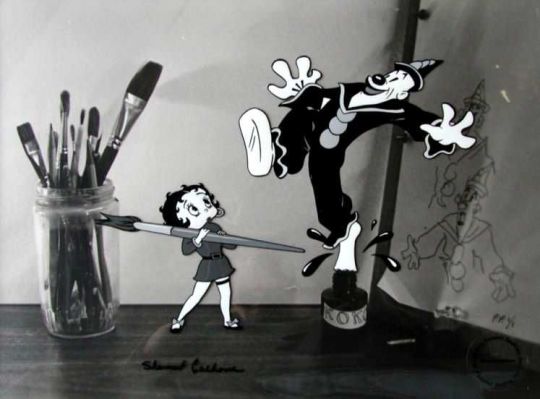
Betty Boop and Koko the clown in a 1938 instalment of the Fleischer brothers’ ‘Out of the Inkwell’ series.
Early crossovers often involve animators playing with their characters, in scenarios such as the inventive Out of the Inkwell series of shorts from Rotoscope inventor Max Fleischer and his director brother Dave. Things get even more interactive mid-century, when Gene Kelly holds hands with Jerry Mouse in Anchors Aweigh.
The 1960s and ’70s deliver ever more delightful family fare involving human actors entering cartoon worlds, notably in the Robert Stevenson-directed Mary Poppins and Bedknobs and Broomsticks, and Chuck Jones’ puntastic The Phantom Tollbooth.

Jerry and Gene dance off their worries in ‘Anchors Aweigh’ (1945).
Mary Poppins is one of the highest-rated live-action/animation hybrids on Letterboxd for good reason. Its sense of control in how it engages with its animated creations makes it—still!—an incredibly engaging watch. It is simply far less evil than the singin’, dancin’ glorification of slavery in Disney’s Song of the South (1946), and far more engaging than Victory Through Air Power (1943), a war-propaganda film about the benefits of long-range bombing in the fight against Hitler. The studio’s The Reluctant Dragon (1941) also serves a propagandistic function, as a behind-the-scenes studio tour made when the studio’s animators were striking.
By comparison, Mary Poppins’ excursions into the painted world—replicated in Rob Marshall’s belated, underrated 2018 sequel, Mary Poppins Returns—are full of magical whimsicality. “Films have added the gimmick of making animation and live characters interact countless times, but paradoxically none as pristine-looking as this creation,” writes Edgar in this review. “This is a visual landmark, a watershed… the effect of making everything float magically, to the detail of when a drawing should appear in front or the back of [Dick] Van Dyke is a creation beyond my comprehension.” (For Van Dyke, who played dual roles as Bert and Mr Dawes Senior, the experience sparked a lifelong love of animation and visual effects.)
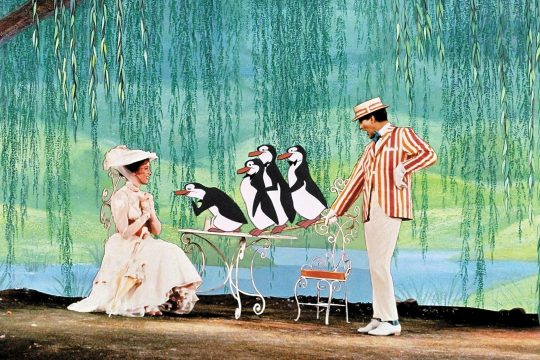
Julie Andrews, Dick Van Dyke and penguins, in ‘Mary Poppins’ (1964).
Generally speaking, and the Mary Poppins sequel aside, more contemporary efforts seek to subvert this feeling of harmony and control, instead embracing the chaos of two worlds colliding, the cartoons there to shock rather than sing. Henry Selick’s frequently nightmarish James and the Giant Peach (1996) leans into this crossover as something uncanny and macabre by combining live action with stop motion, as its young protagonist eats his way into another world, meeting mechanical sharks and man-eating rhinos. Sally Jane Black describes it as “riding the Burton-esque wave of mid-’90s mall goth trends and blending with the differently demonic Dahl story”.
Science-classroom staple Osmosis Jones (2001) finds that within the human body, the internal organs serve as cities full of drawn white-blood-cell cops. The late Stephen Hillenburg’s The Spongebob Squarepants Movie (2004) turns its real-life humans into living cartoons themselves, particularly in a bonkers sequence featuring David Hasselhoff basically turning into a speedboat.
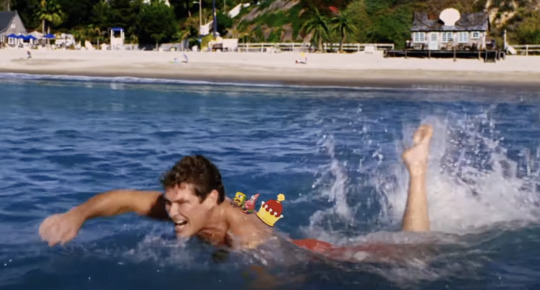
David Hasselhoff picks up speed in ‘The Spongebob Squarepants Movie’ (2004).
The absurdity behind the collision of the drawn and the real is never better embodied than in another of our highest-rated live/animated hybrids. Released in 1988, Robert Zemeckis’ Who Framed Roger Rabbit shows off a deep understanding—narratively and aesthetically—of the material that it’s parodying, seeking out the impeccable craftsmanship of legends such as director of animation Richard Williams (1993’s The Thief and the Cobbler), and his close collaborator Roy Naisbitt. The forced perspectives of Naisbitt’s mind-bending layouts provide much of the rocket fuel driving the film’s madcap cartoon opening.
Distributed by Walt Disney Pictures, Roger Rabbit utilizes the Disney stable of characters as well as the Looney Tunes cast to harken back to America’s golden age of animation. It continues a familiar scenario where the ’toons themselves are autonomous actors (as also seen in Friz Freleng’s 1940 short You Ought to Be in Pictures, in which Daffy Duck convinces Porky Pig to try his acting luck in the big studios).
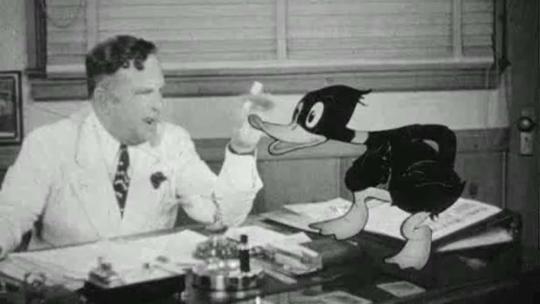
Daffy Duck plots his rise up the acting ranks in ‘You Ought to Be in Pictures’ (1940).
Through this conceit, Zemeckis is able to celebrate the craft of animation, while pastiching both Chinatown, the noir genre, and the mercenary nature of the film industry (“the best part is… they work for peanuts!” a studio exec says of the cast of Fantasia). As Eddie Valiant, Bob Hoskins’ skepticism and disdain towards “toons” is a giant parody of Disney’s more traditional approach to matching humans and drawings.
Adult audiences are catered for with plenty of euphemistic humor and in-jokes about the history of the medium. It’s both hilarious (“they… dropped a piano on him,” one character solemnly notes of his son) and just the beginning of Hollywood toying with feature-length stories in which people co-exist with cartoons, rather than dipping in and out of fantasy sequences. It’s not just about how the cartoons appear on the screen, but how the human world reacts to them, and Zemeckis gets a lot of mileage out of applying ’toon lunacy to our world.
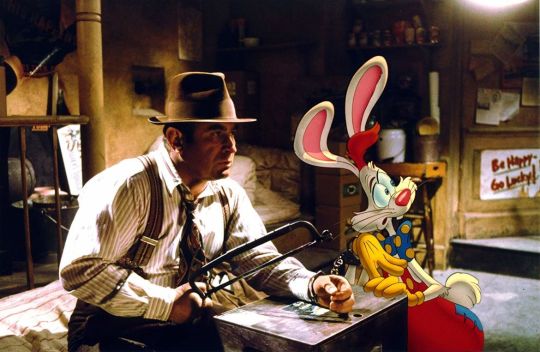
Bob Hoskins in ‘Who Framed Roger Rabbit?’ (1988).
The groundbreaking optical effects and compositing are excellent (and Hoskins’ amazing performance should also be credited for holding all of it together), but what makes Roger Rabbit such a hit is that sense of controlled chaos and a clever tonal weaving of violence and noirish seediness (“I’m not bad… I’m just drawn that way”) through the cartoony feel. And it is simply very, very funny.
It could be said that, with Roger Rabbit, Zemeckis unlocked the formula for how to modernize the live-action and animation hybrid, by leaning into a winking parody of what came before. It worked so perfectly well that it helped kickstart the ‘Disney renaissance' era of animation. Roger Rabbit has influenced every well-known live-action/animation hybrid produced since, proving that there is success and fun to be had by completely upending Mary Poppins-esque quirks. Even Disney’s delightful 2007 rom-com Enchanted makes comedy out of the idea of cartoons crossing that boundary.
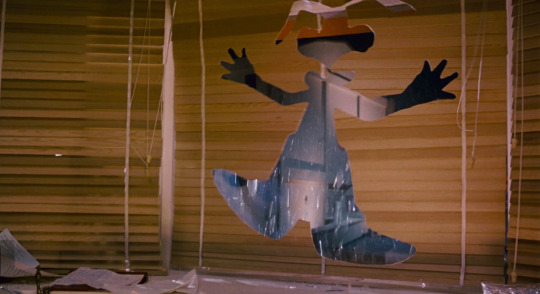
When a cartoon character meets real-world obstacles.
Even when done well, though, hybrids are not an automatic hit. Sitting at a 2.8-star average, Joe Dante’s stealthily great Looney Tunes: Back in Action (2003) is considered by the righteous to be the superior live-action/animated Looney Tunes hybrid, harkening back to the world of Chuck Jones and Frank Tashlin. SilentDawn states that the film deserves the nostalgic reverence reserved for Space Jam: “From gag to gag, set piece to set piece, Back in Action is utterly bonkers in its logic-free plotting and the constant manipulation of busy frames.”
With its Tinseltown parody, Back in Action pulls from the same bag of tricks as Roger Rabbit; here, the Looney Tunes characters are famous, self-entitled actors. Dante cranks the meta comedy up to eleven, opening the film with Matthew Lillard being accosted by Shaggy for his performance in the aforementioned Scooby Doo movie (and early on throwing in backhanded jokes about the practice of films like itself as one character yells, “I was brought in to leverage your synergy!”).
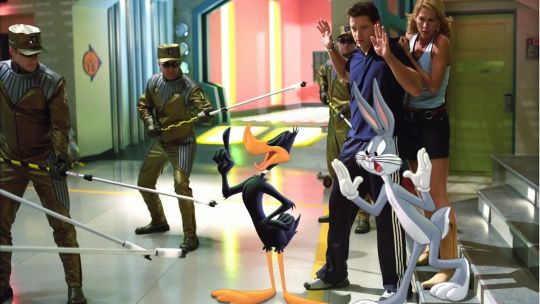
Daffy Duck with more non-stop banter in ‘Looney Tunes: Back in Action’ (2003).
Back in Action is even more technically complex than Roger Rabbit, seamlessly bringing Looney Tunes physics and visual language into the real world. Don’t forget that Dante had been here before, when he had Anthony banish Ethel into a cartoon-populated television show in his segment of Twilight Zone: The Movie. Another key to this seamlessness is star Brendan Fraser, at the height of his powers here as “Brendan Fraser’s stunt double”.
Like Hoskins before him, Fraser brings a wholehearted commitment to playing the fed-up straight man amidst cartoon zaniness. Fraser also brought that dedication to Henry Selick's Monkeybone (2001), a Roger Rabbit-inspired sex comedy that deploys a combo of stop-motion animation and live acting in a premise amusingly close to that of 1992’s Cool World (but more on that cult anomaly shortly). A commercial flop, Back in Action was the last cinematic outing for the Looney Tunes for some time.
Nowadays, when we think of live-action animation, it’s hard not to jump straight to an image of Michael Jordan’s arm stretching to do a half-court dunk to save the Looney Tunes from slavery. There’s not a lot that can be fully rationalized about the 1996 box-office smash, Space Jam. It is a bewildering cartoon advert for Michael Jordan’s baseball career, dreamed up off the back of his basketball retirement, while also mashing together different American icons. Never forget that the soundtrack—one that, according to Benjamin, “makes you have to throw ass”—includes a song with B-Real, Coolio, Method Man and LL Cool J.
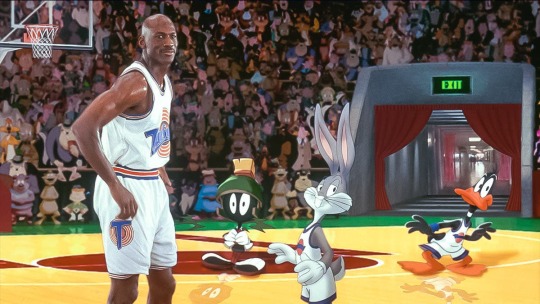
Michael Jordan and teammates in ‘Space Jam’ (1996).
Space Jam is a film inherently born to sell something, predicated on the existing success of a Nike commercial rather than any obvious passion for experimentation. But its pure strangeness, a growing nostalgia for the nineties, and meticulous compositing work from visual-effects supervisor Ed Jones and the film’s animation team (a number of whom also worked on both Roger Rabbit and Back in Action), have all kept it in the cultural memory.
The films is backwards, writes Jesse, in that it wants to distance itself from the very cartoons it leverages: “This really almost feels like a follow-up to Looney Tunes: Back in Action, rather than a predecessor, because it feels like someone watched the later movie, decided these Looney Tunes characters were a problem, and asked someone to make sure they were as secondary as possible.” That attempt to place all the agency in Jordan’s hands was a point of contention for Chuck Jones, the legendary Warner Bros cartoonist. He hated the film, stating that Bugs would never ask for help and would have dealt with the aliens in seven minutes.
Space Jam has its moments, however. Guy proclaims “there is nothing that Deadpool as a character will ever have to offer that isn’t done infinitely better by a good Bugs Bunny bit”. For some, its problems are a bit more straightforward, for others it’s a matter of safety in sport. But the overriding sentiments surrounding the film point to a sort of morbid fascination with the brazenness of its concept.
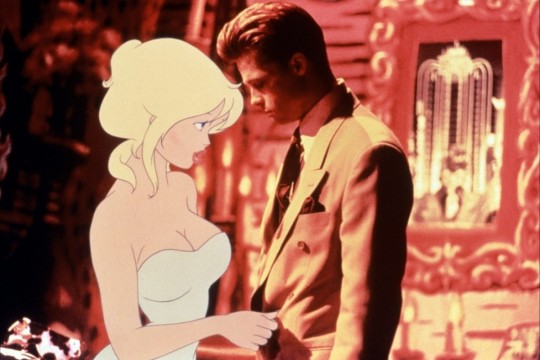
Holli Would (voiced by Kim Basinger) and Frank Harris (Brad Pitt) blur the lines in ‘Cool World’ (1992).
Existing in the same demented… space… as Space Jam, Paramount Pictures bought the idea for Cool World from Ralph Bakshi as it sought to have its own Roger Rabbit. While Brad Pitt described it as “Roger Rabbit on acid” ahead of release, Cool World itself looks like a nightmare version of Toontown. The film was universally panned at the time, caught awkwardly between being far too adult for children but too lacking in any real substance for adults (there’s something of a connective thread between Jessica Rabbit, Lola Bunny and Holli Would).
Ralph Bakshi’s risqué and calamitously horny formal experiment builds on the animator’s fascination with the relationship between the medium and the human body. Of course, he would go from the immensely detailed rotoscoping of Fire and Ice (1983) to clashing hand-drawn characters with real ones, something he had already touched upon in the seventies with Heavy Traffic and Coonskin, whose animated characters were drawn into real locations. But no one besides Bakshi quite knew what to do with the perverse concept of Brad Pitt as a noir detective trying to stop Gabriel Byrne’s cartoonist from having sex with a character that he drew—an animated Kim Basinger.
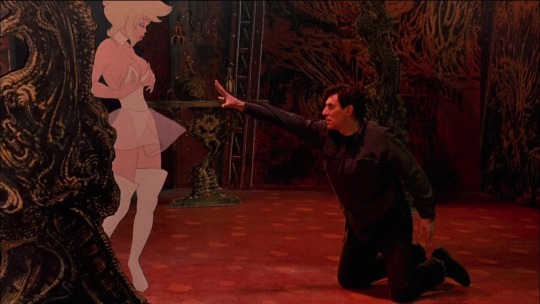
Jack Deebs (Gabriel Byrne) attempts to cross over to Hollie Would in ‘Cool World’ (1992).
Cool World’s awkwardness can be attributed to stilted interactions between Byrne, Pitt and the animated world, as well as studio meddling. Producer Frank Mancuso Jr (who was on the film due to his father running Paramount) demanded that the film be reworked into something PG-rated, against Bakshi’s wishes (he envisioned an R-rated horror), and the script was rewritten in secret. It went badly, so much so that Bakshi eventually punched Mancuso Jr in the face.
While Cool World averages two stars on Letterboxd, there are some enthusiastic holdouts. There are the people impressed by the insanity of it all, those who just love them a horny toon, and then there is Andrew, a five-star Cool World fan: “On the surface, it’s a Lovecraftian horror with Betty Boop as the villain, featuring a more impressive cityscape than Blade Runner and Dick Tracy combined, and multidimensional effects that make In the Mouth of Madness look like trash. The true star, however, proves to be the condensed surplus of unrelated gags clogging the arteries of the screen—in every corner is some of the silliest cel animation that will likely ever be created.”
There are even those who enjoy its “clear response to Who Framed Roger Rabbit”, with David writing that “the film presents a similar concept through the lens of the darkly comic, perverted world of the underground cartoonists”, though also noting that without Bakshi’s original script, the film is “a series of half steps and never really commits like it could”. Cool World feels both completely deranged and strangely low-energy, caught between different ideas as to how best to mix the two mediums. But it did give us a David Bowie jam.
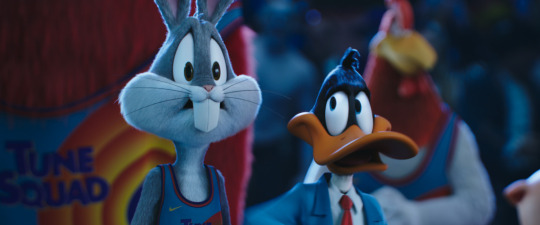
‘Space Jam: A New Legacy’ is in cinemas and on HBO Max now.
Craft is of course important, but generally speaking, maybe nowadays a commitment to silliness and a sincere love for the medium’s history is the thing that makes successful live-action/animation hybrids click. It’s an idea that doesn’t lend itself to being too cool, or even entirely palatable. The trick is to be as fully dotty as Mary Poppins, or steer into the gaucheness of the concept, à la Roger Rabbit and Looney Tunes: Back in Action.
It’s quite a tightrope to walk between good meta-comedy and a parade of references to intellectual property. The winningest strategy is to weave the characters into the tapestry of the plot and let the gags grow from there, rather than hoping their very inclusion is its own reward. Wait, you said what is coming out this week?
Related content
Rootfish Jones’s list of cartoons people are horny for
The 100 Sequences that Shaped Animation: the companion list to the Vulture story
Jose Moreno’s list of every animated film made from 1888 to the present
Follow Kambole on Letterboxd
#kambole campbell#mary poppins#ralph bakshi#hayao miyazaki#ghibli#disney#who framed roger rabbit#roger rabbit#spongebob squarepants#spongebob#animation#live action animation#live action animation hybrid#stop motion animation#stop motion#wes anderson#brad pitt#bob hoskins#genre#space jam#space jam a new legacy#michael jordan#lebron james#looney tunes#bugs bunny#daffy duck#warner bros#2d animation#letterboxd
26 notes
·
View notes
Text
Since the Osmosis Jones cartoon basically did a bunch of the early 2000's cartoon tropes ( Fighting your evil twin, overcoming a phobia, unfortunate mpreg episode, kind of a gender swap ) I'm surprised they didn't do a body swap episode?
And no I don't mean "Out of Body Experience" where Ozzy ends up in Christine. I mean an episode where he and Drix somehow switch bodies. If they did those other tropes you'd know they'd find a way to make that happen if the show went on longer.
42 notes
·
View notes
Note
Bowserinthesky, I have to tell you something very important... did with this information as you will.
The lego people form all. You are one of them. Your body is many of them. You think you're the one breathing? They move your lungs just as they beat your heart. You think you're the one thinking and judging these words you're reading? They whisper the thoughts into your head.
And the lego people in turn are made of lego people. It's lego people controlling lego people "all the way down" with no beginning and no end and you're sandwiched somewhere in between eternity and forever.
And you're not just one of the lego people, you're all of them. They are your mirror reflections scattered across spacetime. Your past, your future, and your potential.
The nature of reality is to ask what should be experienced within the void of nothing. That question is all there is.
"In the beginning there was the word."
Then when that question is asked, you ask what that question is. Then you ask what THAT new question is.
So we are constantly asking "what is this question? " when we look out at the world around us. The world is always tempting us to figure it out and to develop our own idea of it.
But the source of the world comes from the very first question: "what should exist in the void", or "what Am I" which in a way are the same questions if you're in a void with nothing but your self.
This recursive seeking creates the infinite YOUs that have been called lego people. They've been called elves and gnomes too. Sometimes people see them as repeated versions of their bodies.
As for the jester, I have less experience with him, though I believe he's an amalgamation of lego people just as everything else is. He's a higher order one. Sort of the mind and the hive of the hivemind. It's possible we each have a jester. It's also possible he's us before we jumped into this multiverse. Us before we asked the question "who am i in a void?", kicking off a Big Bang of self-recursive discovery. He seems to play a managing role, so i could see him as the us before this reality, conducting the lego people to form our experience.
He's trapped in the same loop of questioning that we are. His questions pertain to our entire reality and what happens when he moves it.
If it helps, you can see the lego people as embodiments of the question they are currently asking within spacetime, and how the answer of your current question looks when factoring their question into account.
Emmet Brickowski and Osmosis Jones are fighting inside my body to decide who takes control of me... The only thing they agree with is that I should keep being gay as hell
2 notes
·
View notes
Text
Some thoughts on the natal chart of Heaven’s Gate
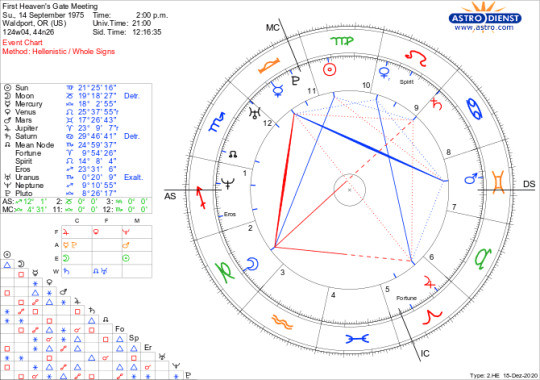
William Lilly (b. 1608) popularized the natal chart as a reflection of the individual, but ancient astrology was utilized more as a lens for global (relatively speaking) events like war, agricultural cycles, weather, and the longevity or character of royal dynasties. I love looking at charts in general but I especially enjoy thinking about events’ inceptions as individual narratives that are socially metabolized. Stories jump out of event charts differently than they do from individual charts. If you are someone who considers your own birth chart or the charts of others, make sure also to explore the dates of different events in your life (books, films etc are also fun to examine in this way). Any moment you select is subject to the same archetypal cast of symbols as is an individual life.
This is a bit Aquarian in the idea that we can examine the social through a zooming out from or the collapsing of individual psychologies into macro, mythic surfaces. In keeping with Aquarian themes, I watched a bit of the new Heaven’s Gate doc last night. I wouldn’t say I’m fascinated by cults etc etc, but I can’t help responding to a birth time, and Heaven’s Gate has one! For me this is an ideal reading, where most of what I know about Heaven’s Gate is largely through osmosis. It wasn’t until after watching some of the first episode that I learned that the buildup to what we consider the culminating event was actually ~20 years in the making. I have not studied the progression of--or figures central to--the movement. Some people do their best work when they are immersed in research of a subject; I myself tend toward flash or impressionism, so I want to capture this phase before I continue watching the documentary.
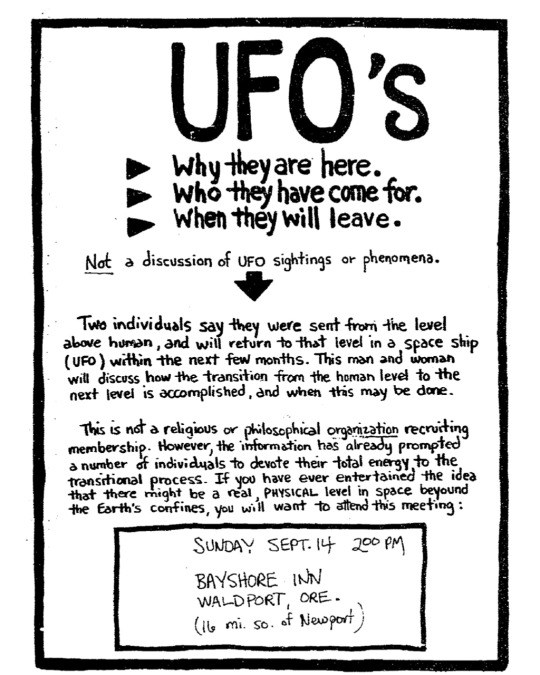
RISING NEPTUNE IN SAGITTARIUS
I’m thinking of this placement less as a moment of inception (the way we might read it in the chart of an individual, as the experience of separation from the body of the parent, becoming a discrete entity) and more descriptive of the way we might encounter the cultural phenomenon of Heaven’s Gate at first glance. It may feel rooted in occultism or obscurity—Sagittarius carries notions of philosophy, education, intellectual magic; I’m thinking of The Magician card and its depiction of a single figure controlling all the elements, convening heaven and earth in their alchemical process of discovery. We often characterize movements as centering around a single idea, or a powerful persona, as with Charles Manson or Jim Jones, but there is always a larger atmosphere to examine. Neptune asks us to look beyond superficial characterizations of events in order to understand their mundanity in equal measure to their mystique. Foucault refers to all research as archaeological in that it is a type of unearthing or excavation, a making-sense of objects that may no longer exist and so deliver not direct answers but different articulations of fragmented meaning. What is important too is that Neptune may represent the illusion of origins and root causes. From Stalker (1979), “I dig for the truth, but while I do, something happens to it.” Obscurity is not dispelled, but re-oriented.
CAPRICORN MOON IN 2ND HOUSE opposite SATURN IN CANCER, 8TH HOUSE
We might think of the moon as the id or the unconscious. Liz Greene describes the difference between the sun and the moon as the difference between aspiration and unconscious emotional need—the former describes an active mode of attainment or embodiment, while the latter is a pulsing lack to which one cannot help but respond. The moon is in detriment in Capricorn, in mutual reception with Saturn, who also experiences detriment in Cancer. This opposition is uncomfortable—the emotional needs are difficult to meet. This difficulty may describe the dispositions of those drawn to the Heaven’s Gate movement; Cancer in 8th may describe one who doesn’t feel “at home”—like the Gnostic subject, who pledges allegiance to the god of an entirely different realm, and must suffer alienation in this realm as a result. The moon’s placement speaks to an unsettled sense of self, a need to strive or work toward a comfortable psychological situation. This moon does not “have enough”—not necessarily in a material sense, but they do feel dispossessed, as if their history and culture do not belong to them, or they do not belong to the history they have been given.
ARIES JUPITER IN 5TH HOUSE
The 5th house speaks to creation, production, a making manifest. What Heaven’s Gate purported to give was a way forward—a strategy, a directive. It doesn’t take particularly complex analysis to guess that for the emotionally listless or dislocated, this resolve would have been seductive. Joan Didion’s collection, The White Album (1979), describes this generation far more incisively and expertly than I will attempt to do here; instead, picture the Aries Jupiter as striding confidently forward without fear, of translating subjective experience into universal understanding, resulting in decisive action. This was not just an idea, but a way to manifest one’s presence in the world; not just about joining a collective, but about using the language of collective experience to articulate higher individual selfhood.
GEMINI MARS IN 7TH TRINE LIBRA MERCURY + PLUTO IN 11TH
With two Geminis exiting the White House next month, it feels important to acknowledge the more toxic stereotypical Gemini qualities at play in tearing the country apart for the last four years (though of course the foundation for such a conflict is deeper-rooted and further-reaching than a single presidential term, as it is unrealistic to attribute the momentum of such movements to simply a demagogue). The Trump argument for a stolen election is one element of what has been described as “mass political disinformation.” Gemini cares less about the truth, and more about how a truth is expressed; less about the effectiveness of an idea, and more about being pleased by its shape. And they won’t be pinned down, held to anything they’ve previously said, if in some later context that thing no longer serves them (if you watch enough Bob Dylan interviews you’ll see what I mean—don’t ask him about folk music, don’t ask him what he believes, don’t ask him where he’s from—if you never tell the truth, then it’s almost like you’re never really lying, you’re just saying things, creating momentum through language).
We can see this stereotype on the one hand as, yes, members of Heaven’s Gate were lied to and manipulated. Gemini’s ruler, Mercury, is a slick operator in Libra. Libra quells doubt, seals holes, soothes unease—all the dynamics involved in the appearance of equilibrium or social harmony. We can see Mercury’s conjunction with Pluto as the god of communication acting in service to the god of death. The rhetoric of Heaven’s Gate is designed to ease its members toward radical sacrifice. The 11th house speaks to communities, groups, friends—the social world, and, in this case, social organization and purpose.
The 7th house is the house of the Other, and is where we may look in an individual’s chart to read their close 1:1 relationships. It would have been important for Heaven’s Gate to discredit the friends and families of their members, to emphasize that these are the people that the members should no longer trust and confide in. The Gemini stereotype here, of manipulation and dishonesty, is projected onto the Other—a Them—to consolidate the self, an Us. Mars here makes the disconnection from loved ones particularly dramatic. Mars wants to cut, to define, to separate; it is the individuating act. It is also worth mentioning Lynn Bell’s description of Mars as the protector of the moon, of the unconscious; if the moon feels threatened, it is Mars who steps in and takes over. If an increased involvement in Heaven’s Gate results in members’ loved one’s questioning their involvement, then it is the deep-seated sense of alienation (the moon) that is heightened, ameliorated by a severing of ties (Mars). If Gemini speaks to duality or two-ness, Mars is about making that division manifest.
LEO VENUS IN 9TH
The 9th House in Hellenistic astrology represents temple work or religious duties, and so for readings of individuals alive today we typically adapt this meaning to describe academic or professional institutions, but here we can really embrace the ancient associations. This is absolutely how the institution of Heaven’s Gate represented itself—transparent, loving, and in loyal service to the good, and to the happiness of its members. The “gate” itself feels as if it refers to a 9th house structure (thinking of heaven elsewhere described as a “kingdom”), with Venus at the threshold guiding members toward an embrace of institutional values. I haven’t looked at the charts for Ti and Do, but it feels significant that they are “the Two”—a platonic pair whose relationship forms the wellspring of the movement, which feels very Venusian. We might place The Lovers card beside the card of The Devil, and see the same figures in both cards. The Lovers’ equivalent in the zodiac, of course, is Gemini.
VIRGO SUN IN 10th
If the moon is the id, the sun is the ego—the conscious experience of the self, the path that is chosen, the disposition by which the self feels most connected to worldly perception. The 10th house, “the crown you wear,” positions the ego identity of Heaven’s Gate; what it thinks it is, as a public organization that is meant to efficiently serve its members—to construct and carry out a plan. It is interesting to think of Virgo and Scorpio on either side of Libra, two weights in balance on the scale; this also describes the Persephone myth, in which Virgo descends to the realm of Scorpio and returns with divine knowledge, incurring the changing of the seasons; whose being is intricately tied to the rotation of the earth. Virgo’s responsibility, then, is to bear the fate of the world in their minute actions. Heaven’s Gate in this way positions itself as serving humanity through a practical, incremental system, which relies on everyone “doing their part.”
SCORPIO URANUS IN 12TH
To me it is difficult to find more aptly conflated synonyms for death, unless maybe you replace Uranus with Pluto. Uranian matters are dramatic, revolutionary. They speak to transformative change—as does the 12th house, as does Scorpio. This placement imbues Heaven’s Gate with such an inevitability of death, but the kind of death that is cosmically resonant in that it has the power to change how death in this context is understood. This 12th house, “the bottoming out,” feels like a reservoir that feeds into the Sagittarian Neptune, the sediment that must be continuously re-worked or rediscovered in whatever form it takes in its periods of hibernation. Neptune in Sagittarius may represent the fossilization process of Uranus in Scorpio. I may have more to say about this once I finish the documentary, but I am looking forward to watching for impressions of how “death” is constructed, or re-made as an artifact of social, extraterrestrial liberation.
5 notes
·
View notes
Photo

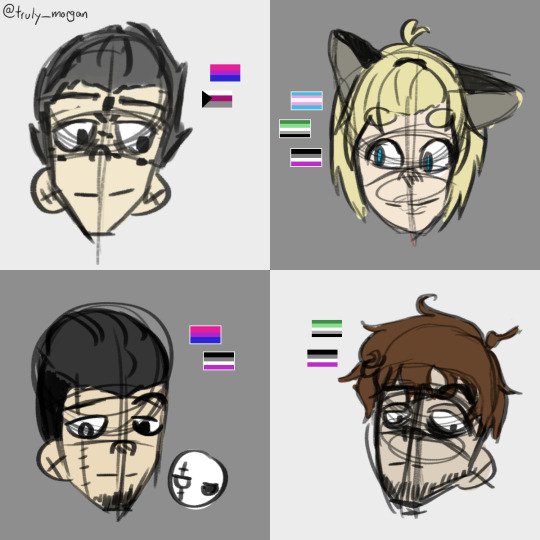
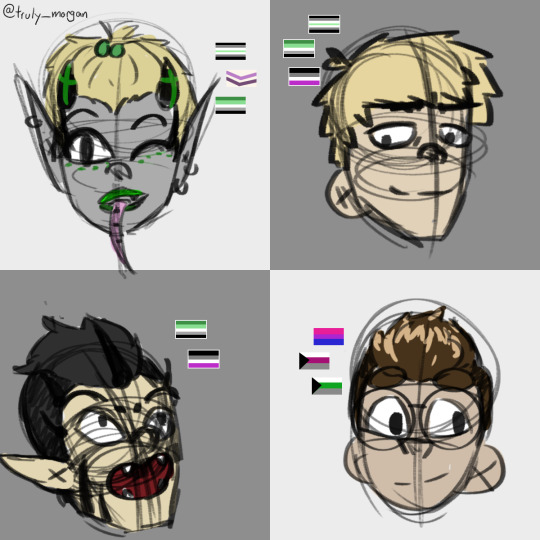


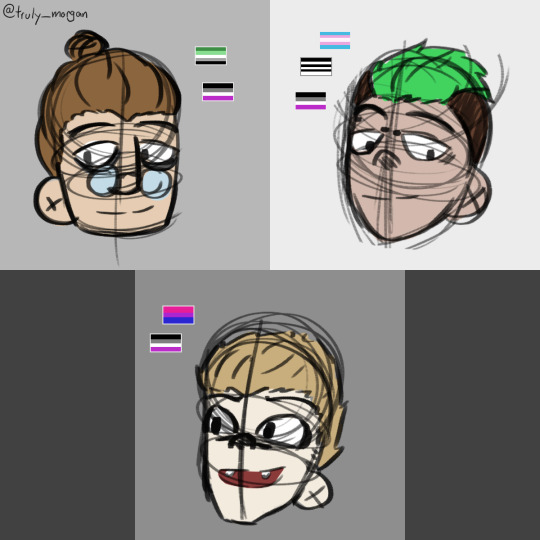
This is (nearly) all my aspec characters
Wanted to do some pride drawing but I feel son drained from working and also my motivation is dying from me never being satisfied of what I make. So here is close to all my Aspec characters (only three missing, but I never designed them before).
I feel like gushing about my characters, so under the cut more about them for those interested.
[from left to right, top to bottom]
> Kyosuke Hamada: Telekinesis artist who’s been stuck in a illegal and underground lab to be studied on since his childhood. Really love sweets and arts, his walls are always full of painting.
> Kadir: A demon who became a bounty hunter after taking example of his three adoptive dad. Pretty short tempered and really powerful, he’s not good at getting along with other people. The only one he could call a friend (more like frenemy) would be Tamir, even though the other demon always tries to piss him off.
> Evan Matsui: A human vessel, he took upon himself the task of carrying a demon so his twin brother doesn’t have to. He’s pretty bad at befriending people and often keep people at a distance to make sure Kuro won’t try something with them. His brother is really precious to him.
> Raph P.: A oc from the movie Osmosis Jones, firstly a white blood cell who then became infected by Thrax but didn’t died. He’s kept by Thrax side mainly as an entertainment, losing parts of his memory easily and somewhat chasing after the virus so he don’t get kill of left behind. I though it was funny to make an body cell ace, I know I’m really funny.
> Nikolaus Fichter: A spider hybrid who’s a librarian after being taken in by one when he was little. Doesn’t goes out much and isn’t really good at socializing, but if someone gets to know him he’s pretty nice and will talk more easily. He’s a total bookworm, which is sort of why he’s often in the bookstore/library.
> Jérémie Prieur: Cat hybrid abandoned by his parent at birth, he’s picked up by a teacher who took care of him. He doesn’t go out of the house much because of his appearance but does like to interact with people online. He can come off as a little naive and innocent at time since he doesn’t have much real life experience, but one shouldn’t believe he has the mind of a kid either.
> Yashiro: A pretty cold man who doesn’t approche people much and prefer being alone. If it wasn’t for Koseki, he would be living in the middle of nowhere all alone, but he needs to take care of this little carefree subterra to makes sure nothing bad happen to them. He got a real soft spot for this little fella even if no one would catch admitting to it out loud and would do anything to keep them safe.
> Samuel Roy: A hitman addicted to coffee who only have one friend and for which anyone else is just a source of annoyance. He don’t care much about other people which help a lot for his job. He lives from day to day and doesn’t really have any plans or dreams for the future, as if he could die tomorrow because of his line of work and accept that fact.
> Keir: An incubus who really love sex and doesn’t really mind who’s their partner. They roam around the human realm to have some fun and eat good food. They can switch their body appearance to whatever could please someone best but often stick to a more masculin and androgyne body.
> Theòs Mortem: Previously a death god before people kicked out of the death realm after pushing people to die earlier than expected by tricking them into dying. They have a really morbid fascination of humans dying from their own hands and will often play mind game to push someone over the edge, but never does anything himself physically. They switch from a masculin to a feminine appearance when needed to be more trustworthy in someone eyes.
> Cassius: a greek dragon who loves to travel around the world, but often stick to Bankei side. He got a grudge against human for causing the dying of his people, in big part at least. Yet, he’s still interested by what said human can do, despite this grudge.
> Jim Campbell: A teenager who believes in alien and who destined a big part of his early teen to fight against an alien who came to earth in an “attempt” to invade it. He loves everything that is supernatural and cryptic, doesn’t really know what to do in the future since this field isn’t something stable and his parents want him to have a good job.
> Billy Anderson: Young boy who loves to cause trouble and would do anything for his two best friends. He’s adventurous and often get himself injured or in trouble, yet it never stop him from having crazy ideas to suggest to his friends. He plan on getting out of the town the moved in and to hopefully still be with those two friends of his.
> Ludwig Lange: A tall demon who works in a freak show as a scene master, even if he come to pull the string behind the scene at some point. He absolutely loves his crew and would do anything to protect them from outsider coming at them. He easily adapt to his time and finds humans to be pretty fascinating.
> Casey McCormick: A little rat hybrid who loves photography, they are pretty shy at first, but once they know you they’re a real chatterbox. They would love to became a professional photograph and practice on their own or with close friend of them.
> Yasuhiro Ogawa: Due to a curse in their family, Yasuhiro is an snake hybrid. They don’t mind it much though since their uncle, who’s the same, made sure to make them feel at ease. They work as an bartender in their best friend gay bar, but will from time to time be a dancer when the bar is short on dancer or when they feel like it since it something they enjoy doing anyway and the only safe way they can show their scale under the pretense of it being prosthetic.
> Cyrus: Little angel who has fallen from heaven after some other took revenge on him and pushed him down after taking away his wings. Once on earth lost all his memories and could only remember his name because of a pendant. He was found by Micha who then decided to keep him under his wing and even let him work at his bar. Cyrus can be a little naive at time and can be easily trick, which is why Micha keeps a close eyes on him.
> Gabriel Woods: He became mute after some injuries cause to his vocal cord by his mother. After the traumatic incident he was taken in by his best friend family who treats him like a family member and do their best to help him heal. He works as a waiter in a small family restaurant where his best friend is also employed even if it can be challenging at time, most costumer are regular who are cooperative when he has some difficulty communicating correctly.
> Sculptor: A sculptor who’s going through hard time after his young daughter death. He goes through his grief with his art, but the support of his friends is what helps him better.
> Han Tsao: Someone who loves art and doing graffiti, working in an antique shop after being caught graffiting over the back wall of the shop. He still became a good friend with the owner and kept working there even after paying back the cost of repainting the wall. He would love to became a professional wall painter artist.
> Sebastiano Leone: Became a vampire when a pandemic broke out in his little town and his wife and daughters were affected. He threw out the window faith and went to follow rumors of a vampire nearby as an attempt to save them, but took too much time convincing the vampire to turn him. His biggest regrets is not being there when his family died. Nowadays he travel around the world, trying to fade into the decor and live normally. He decided and promised to himself he would keep on living since he know his wife wouldn’t want him to end is life just to join them, carrying an old locket with his family portrait as a way to make them keep on living too.
#my art#original character#aspec#queer#also fuck logic with Raph I dont know if it even possible#let say thrax virus can do that on white cell#aspec characters#sebastiano leone#han tsao#sculptor (oc)#gabriel woods#cyrus#yasuhiro ogawa#casey mccormick#ludwig lange#billy anderson#jim campbell#cassius#keir#samuel roy#yashiro#jérémie prieur#nikolaus fichter#raph p.#evan matsui#kadir#kyosuke hamada#theòs mortem
10 notes
·
View notes
Text
Summer 2018 Anime Overview: Cells at Work! and My Hero Academia Season 3 (Episodes 52-63)
Cells at Work!

Cells at Work follows anthropomorphic personifications of cells, all busily doing what they can to keep the body they inhabit running. Their surroundings look like a regular city, so yeah, a bit different from Osmosis Jones. The main characters are Red Blood Cell, a passionate courier with no sense of direction and White Blood Cell, a subdued fellow who nevertheless fights off invading bacteria with great gusto. But there are plenty of other cells to get to know as well.
Cells at Work is edutainment aimed at kids, but it is still entertaining as a narrative in its own right. It’s just....really cute. The dramatic ways the anime represents various crises in the body is good and the characters are largely charming.

Considering that it is aimed for kids, it’s kind of hilarious how bloody it is (every time there’s a fight with bacteria expect it to basically rain red stuff). But hey, that proves the show knows its audience. I certainly loved blood and guts as a kid. And stuff like the sneezes being presented as missiles and whatnot is also pretty creative.
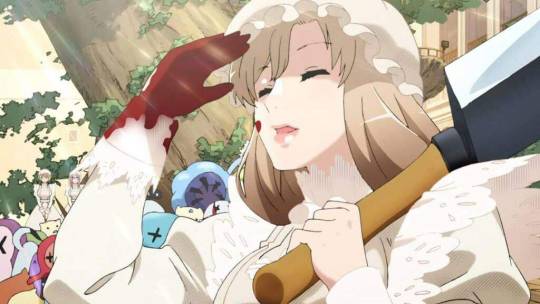
The way each cell is personified is fun. From the adorable little platelets to the eccentric Memory cell, there’s a lot to love. I was at first a bit concerned that the “warrior” cells seemed to be mostly represented by men, but that concern is somewhat mollified when several fighting girl cells made the scene. I have great affection for the macrophages, because soft and sweet characters who are also KILLING MACHINES always have a place in my heart.

I also have to give a shoutout to NK Cell for owning my entire life with her badassery and muscular arms, I’m in love with a cell, this is what anime has done to me.
The one warning I do have about the show is there’s an episode that kinda presents cancer cells as some tragic doomed villain you should feel bad for and I can see how that would be uncomfortable and upsetting for people who’ve had their lives affected by cancer. I get what they were going for- (cancer cells should have been normal cells that helped the body, but due to circumstances they ‘come out wrong’ and have to be purged, if you humanize that its naturally a pretty terrible fate)- but it was a little...yeah, a little weird.

But other than that, if you want a cute and light show that also contains rivers of blood and near death experiences, all while teaching you about how your body works, it’s a solid watch. It’s by no means deep and complex and the narration can sometimes be a bit much, but its a good time.
My Hero Academia Season 3 (Episodes 52-63)
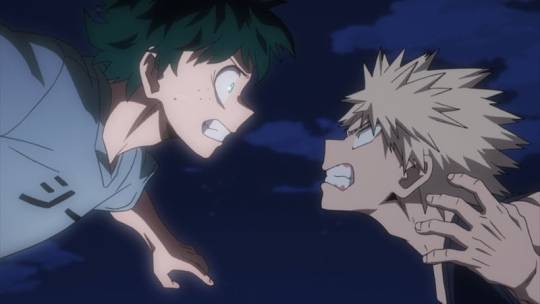
My Hero Academia continues as Deku and his classmates face the exams to get their provisional hero licenses.
Largely, this part of the season was nothing to write home about, especially compared to the awe-inspiring intensity of the arc that preceded it. It was a shonen exam arc and the stakes were pretty low. The flaws that dog MHA stood out all the more because of it- the girls being unnecessarily sexualized and underrepresented etc, you know the drill.
However, there were some fun character moments in there and also a couple stellar episodes. “Deku vs Kacchan Part 2″ both looked great and was among the best in the series as far as writing goes- it was a big turning point and really bought the feels.
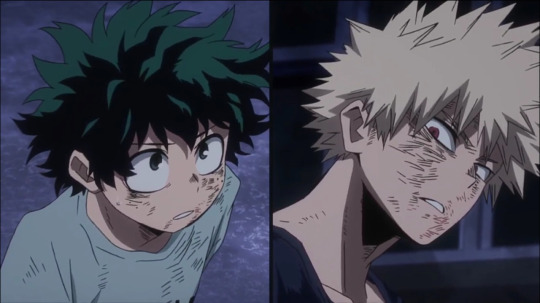
This season has been really good for Bakugou, shedding light on what makes him tick. The journey with him in this series has been interesting- I went from feeling annoyed indifference in season 1, to finding him kinda hilarious at times in season 2, and now I feel like I genuinely find him to be an interesting, fully fledged character, even if he’s still an asshole.
He’s been challenged a LOT this season and the fact he was finally open about his fear, guilt and vulnerability in that episode is a pretty big deal. He doesn’t have a tragic backstory to fuel his actions, but you can still see how he built up this weird toxic worldview that is starting splinter a bit. In contrast, Deku’s gotten a lot more confident and secure in himself and he really showed it in that ep.

Other things I like about this season include the extra screentime given to Momo that apparently wasn’t in the manga, which allowed her to show how she’s developed as a leader (even if the fact she constantly compares herself to dudes is getting tiring).
Unfortunately, the movie tie-in extra episode was not nearly as elegant anime-original material- it jarringly disrupted the arc with a non-sequitur and the whole plot and concept was just incredibly dumb (Apparently one of UA’s test is to see if you can guess ridiculous overelaborate romantic drama scenarios the teachers come up with off of basically nothing! And that’s important for being a hero...because! And Deku somehow, very inexplicably, managed to guess the whole stupid scenario! But still failed!). Oh well.
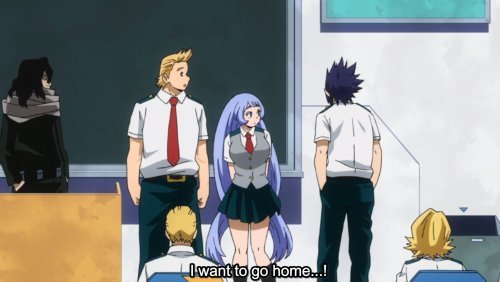
The new characters introduced in this season were also charming so far and I’m interested to see what their stories are.
But yeah, overall, this was a fairly unremarkable arc. Aside from some good moments (like Todoroki returning to confront his issues again) and one really good episode, it was pretty standard stuff and I enjoyed it okay, but it definitely didn’t blow my mind. You can read my full recap for more details.

But ofc, I will be watching the fourth season. MHA is a deeply flawed series, but I adore most of the characters and want to see how their stories go. And when it’s good, this series is really good.
#cells at work#cells at work!#my hero academia#boku no hero academia#izuku midoriya#momo yaoyorozu#Katsuki Bakugou#summer 2018 anime#anime overview#hataraku saibō
42 notes
·
View notes
Text
Weekly Spotlight #1
So, to kind of get this blog off the ground until I get a steady flow of requests coming in, I’m going to start a running bit that I’m calling the Weekly Spotlight where I’ll talk about cartoons that you may or may not know and break them down so you can see whether you want to rewatch it or not.
So! For out first spotlight of the week, I’m going to be discussing---
*drum roll*
Ozzy and Drix!
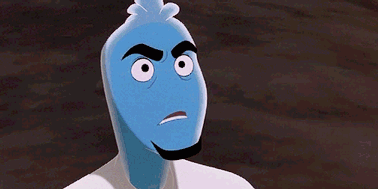
This show is... a bit of a bizarre one.
I’m sure that many of you remember the infamous live-action/animation hybrid known as Osmosis Jones, featuring Bill Murray and Chris Rock as the leading roles to this... dumpster fire. For those of you who never saw this movie, or have fortunately blocked it from your memory, Osmosis Jones follows the life of an individual named, Frank Detorre (played by Bill Murray) who tries to pick up the pieces of his life as it seems to be getting worse and worse from his poor health choices. Meanwhile inside of Frank’s body, Osmosis Jones (played by Chris Rock), a white blood cell with a bit of a rebellious streak, and a cold-pill Drixenol (”Drix”) (played by William Shatner) try to fight off a deadly infection named Thrax as it attempts to ravage Frank’s immune system and kill him. This movie follows the whole “buddy cop” dynamic, with a bit of live-action gross-out humor because... it’s Bill Murray??? I’m not really sure why the chose this directional choice but... okay. Honestly, the best part of this movie was the animation as it seemed relatively interesting and at least the basic understanding of the medical science seemed fairly correct.
Well, about a year later, guess who got made into an animated TV show?
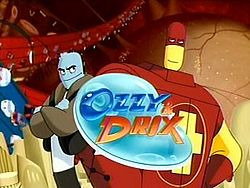
Yep. These guys.
From the years 2002-2004, this show was produced by Warner Bros. Animation and premiered on Kids’ WB. Of course, this show was very short-lived, only producing 2 seasons, and ended up rerunning on Cartoon Network from 2004 to 2006.
Now, in order to understand the animated series, you have to watch the pilot; otherwise, you will be completely and utterly lost when you watch this series, because it completely diverges from the ending of the original movie. At the end of Osmosis Jones, Frank declares that he’ll start changing his health ways, Jones is declared a hero, and you get the stereotypical “Happily-Ever-After” ending. From the start of the animated series however, there are a few... continuity errors. We open up the series with a shot of Frank eating terrible junk food, being a complete and total slob, and overall just... a vague sense of the gross-out humor that plagued the movie. When we enter inside Frank’s body, we see that Jones (now nicknamed, Ozzy) and Drix are tracking down a bacterium that causes Scarlet Fever with the intention of gaining a promotion. While chasing down the Scarlet Fever, Ozzy, Drix and the Scarlet Fever are sucked up by a mosquito and transported into a young boy named Hector. They then spend the rest of the episode proving their worth, trying to fit into this “new home,” and overall, establishing the setting, cast, and problems that would become the rest of the series.
Some might be upset with this change of setting and characters, especially when it appears that this show seems to be a way for producers to promote healthy choices and healthy living, but when it comes down to it, the choices made in this series make sense. The TV series obviously wanted to get away from the gross-out humor, the terrible live-action crap, and just focus on an interesting concept that promoted kids’ health. The humor is pretty clever, the medical science is fairly accurate (aside from the fact that Ozzy would be attacked by Hector’s white blood cells as a “foreign” object and destroyed regardless of blood type compatibility), and for the most part, their messages are pretty wise to send to kids. They explain to the audience, without making the show too preachy or too “on the nose”, the effects of making poor health decisions such as the dangers of eating undercooked food, the adverse effects of having a diet high in sugar content, the hazards of potentially picking the bad habit of smoking.
Though... there are some episodes that... didn’t appear to have a clear point...? Such as the episode “Reflex” in which Hector simply... “scared” his bully into not beating him up? Which... really doesn’t really seem like a wise example to be showing to kids. As well as the two part episode called “Out of Body Experience”, that postulates while in another sex’s body, blood cells turn into the other sex (i.e. male cells turn into female cells in a female body) which... is... flat out wrong??? And, looking over this egregious error, what exactly is this teaching kids? That girls aren’t that different from guys? Why couldn’t we have that sort message in a plot involving one of the canon female characters of the show? That seems like a better way to get across that message. Another question in fact--- how does Hector have “female” cells in a male body (if we’re following the show’s... weird logic)? It honestly felt like a weird excuse to have a bit of a Genderbend fun and ask the question, “What would it be like if Ozzy and Drix were girls???”
And it’s...

just...

weird...
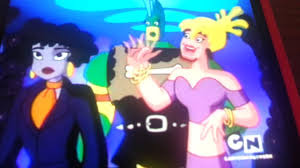
Regardless, I feel like this show isn’t as bad as you would think or as others might try to make it out to be. Is it cringy at times? Yes. Of course. It’s the early 2000s; what did you expect? Do their plots make sense? Eh... sometimes. It could be better. But as a show, was it good at promoting kids’ health? Absolutely. It made learning about the body fun, and promoted (for the most part) very wise and healthy habits for children to maintain into adulthood. Some of its jokes and humor are very subtle and even directed towards adults at times. When researching on whether or not they followed medical validity, I was surprised on how much was true to real life. They correctly described the functions of several body parts; they accurately described several different diseases; they follow cell biology (for the most part) fairly strictly; they even had some clever quips of dialogue that highlighted the anatomy of a cell: “You’re pullin’ my membrane!”
One of the things I was a little disappointed in was the amount of times I saw the animation recycle clips from the original movie in their TV show. The animation between the movie and the T.V. show is also very apparent. Much of the original animation was a mixture of 2D and 3D animation that is probably some of the best I’ve seen--- especially for early 2000s work! But for the TV show, they stuck primarily to 2D animation, which makes sense. It fits the aesthetic of the show; it’s a lot easier to produce (at least at this time period); and it allows them to make the show within a timely manner. I would allow this downgrade to slide, if it wasn’t for the fact that you directly rip scenes and shots from the movie to show off in your show, like “Look at how cool this is! It’s it great! It looks amazing! We’re just as cool as that, right guys? ...Right?” And it seems... kinda like cheating if I’m honest.
Overall, I’d say this TV show wasn’t the worst I’ve seen. Would I watch it again? Probably not. It wasn’t really intended for my demographic and it really shows. Would I ever show this to my kids? I might. It’s not the worst program out there and really, it’s a fairly good motivator for kids to start caring about taking care of their body--- and if you create healthy habits while they’re young, they’ll be more likely to stick with them into adulthood. But... there are just some things about this show that just don’t sit the best with me and I’m not entire sure why. The animation hasn’t aged the best and... well... it’s just not as interesting as some other cartoons in the past.
Rating this T.V. show out of 10, I give it 5.5 stars.
It’s not bad. It’s not good. It’s just kind of... forgettable, and weird. But who knows? Maybe this is your jam and you love this cheesy early 2000s animation. But as for me, I’m just going to let this show fade into the shelves of my vault, only to be remembered in times of really weird Biology classes.
[Edit (8/11/2018) : I changed a bit of grammar, reorganized some sentence structures, and overall, fixed errors that got through my post the first time.]
If there are any corrections you’d like to make in regards to this post, please feel free to send me a message with the corrections and I’ll get back to it as soon as I can!
Do you remember a cartoon your friends have never heard of? Got a scene from an animated film that you’re dying to know the name to? Send your questions to The Cartoon Archivist and I’ll see what I’ve got in the vault!
#ozzy and drix#osmosis jones#Cartoon network#Kids' WB#cartoons#early 2000s#Weekly Spotlight#Does this count as educational television????#Ehh... I'll keep it off because it's not 100% accurate#This was a weird one to tag tbh#It's... just a weird show honestly; nothing else to it
11 notes
·
View notes
Text
Ice Spice & Nicki Minaj - Princess Diana (From "Osmosis Jones: Out of The Body Experience") (Official Music Video)
#osmosis jones#ozzy and drix#osmosis jones 2021#ozzy and drix 2022#out of the body experience#osmosis jones out of the body experience#hbo max#max originals#christine kolchuck#ice spice#nicki minaj#princess diana#hip hop#drill#soundtrack#city of christine#hector x christine#original song#music video
6 notes
·
View notes
Text
Osmosis Schnee sloppy summary:
Vocaloid/RWBY crossover based on Osmosis Jones. AKA “Inside Out but with the body”.
Luka cooks a tuna steak for Neru, but she didn’t cook it well enough and some portions are raw. Neru eats the steak and gets sick. Weiss is a white blood cell inside Neru’s body and she has to fight the germs. Ruby is a red blood cell, and Yang is a platelet (AKA yellow blood cell). Neru takes a Pepto Bismol for her stomach, and the medicine goes in her body and becomes Bismuth Blake Belladonna. (How about that alliteration? Pepto actually turns black in your mouth, by the way.)
Weiss and Blake fight a bunch of monsters together and go through hell together and have an adventure. However, Weiss accidentally does things wrong and ends up destroying some of Neru’s internal organs. Neru then starts to experience organ failure because of it so her friends rush her to the hospital. Weiss and Blake have to do something or else Neru will die and so will they.
At the end, Weiss and Blake form a strong bond, but Blake then has to leave forever because she isn’t a natural part of the body and she’s done her job. Weiss doesn’t want for Blake to leave and cries as she exits Neru’s body in a dramatic fashion. (Taking a crap has never been so emotional.)
Weiss seeks comfort in Ruby and Yang after losing her friend.
And that’s all I have.
1 note
·
View note
Text
Developer: WayForward| Publisher: WayForward| Release Date: 20/02/2020
Price: $19.99/£15.14 | Review Code Provided by The Publisher | Genre: Adventure, Puzzle | Platform: Nintendo Switch
Description/StoryLine
Vitamin Connection lets players take control of Vita-Boy and Mina-Girl, co-pilots of the microscopic Capsule Ship, who must defend the Sable family against a putrid pathogenic invasion. As you eliminate foes with your Vitamin Beam, navigate maze-like environments, and interact with quirky allies, you’ll save the Sables — and maybe even the world! — from numerous wacky situations that are brought to life through a pulse-pounding soundtrack and Switch-only features such as HD Rumble and IR Motion Camera support. Players will even get to engage in a variety of Sub-Game challenges at “vital locations” throughout their journey, where they’ll twist, grab, dance, and deflect their way to victory.
In addition to the single-player game, Vitamin Connection offers an asymmetric local co-op mode, in which two players take advantage of unique Joy-Con controls to fight the microbial menace together. With one player handling the Capsule Ship’s movement and shooting, and the other focusing on rotation and aiming, a connection between players is crucial to success!
Key Features
Battle bacteria with your Capsule Ship across six colorful worlds plus numerous bonus stories!
Play a variety of Sub-Games featuring precision twisting, rhythmic action, IR-based reflex tests, and other challenges!
Unique and innovative Joy-Con controls with HD Rumble!
Jam to an international music collaboration covering everything from J-pop to hip hop!
Play solo or team up with a friend in the asymmetric two-player mode!
Unlock “New Game Pro” mode to experience the story from a whole new perspective as the anti-hero…Pro-Biotic!
Exclusively on Nintendo Switch!
Overview
Vitamin connection shows how medicine works within the body of a person or animal in a fun and delightful way of expressing the feeling. it kinda reminds one of the 2001 movie “Osmosis Jones” where the human swallowed a pill to get healthy and that is how I’m imagining the game like, to be honest. Give or take you can’t go a day without having funny imagination of how pills work within one’s body and this game is showing us gamers the mechanics and functionality of how medicine works (as I mentioned before).
Gameplay/Controls
Vitamin Connection has sub-games in which one will have to unlock through the progress of the main story.
the three first sub-games are Wire coaster, Dance Festival, and Grab Fever.
Wire coaster reminds me of the board game called Simple Buzz wire in which one will have to be careful which playing, just like the buzz wire game.
Dance Festival focuses on how you interact well with the environment of the stage and trust me you’ll be extra careful.
finally, Grab Fever reminds me of the popular game you’ll find in Arcade stores called “The Claw” but with a hint that you’ll have to find out once you get the game.
Each sub-game is challenging, That I have to think of how to beat each game right in front of me.
The gameplay reminds of the popular Nokia Mobile game called “Space Impact”, I loved that game when I first played and playing the main story brings back that the retro mobile gaming vibe that I missed and loved.
The controls, however, are different from the other space shooting game instead of using blasters, you’ll be using mainly beams or “Vitamin Beams” as it’s called within the game.
So I’ll say the developers did an awesome job on the controls.
Audio
The soundtrack is what I can call straight out of anime, like there is anime music while playing and I can say I’m enjoying the music, It sets the moods right and gives one a reminder of what new anime to add on their watchlist.
Verdict
Storyline – 8.9/10
Gameplay/Controls – 9
Audio – 8.5
Overall – 9/10
Thanks for reading this and also a big THANK YOU to the publishers for giving me this opportunity to do a review.
Below is what you’ll expect in the game, enjoy!!!
This slideshow requires JavaScript.
Please show your support on Epic, cause I’m on the Support-a-creator program. My code is on the image below.
[Review] Vitamin Connection – Nintendo Switch Developer: WayForward| Publisher: WayForward| Release Date: 20/02/2020 Price: $19.99/£15.14 | Review Code Provided by The Publisher | Genre: Adventure, Puzzle | Platform: Nintendo Switch…
0 notes
Text
Osmosis Jones: Out of the Body Experience Soundtrack
Genres: Hip Hop • R&B • Pop Rap • trap
JT Money - Bad Bitty
GloRilla - Wanna Be (With Megan Thee Stallion)
Rita Ora - Big (With David Guetta, Imanbek, and Gunna)
6arelyhuman - Party Like The 80s (With asteria and kets4eki)
Madison Beer - Baby
Megan Thee Stallion - BOA
Sassy Secne - Faster n Harder (With 6arelyhuman and Tara Yummy)
Odetari - Break A Neck (With Ayesha Erotica and ODECORE)
Lay Banks - Tell Ur Girlfriend
MISS LUXURY - Tipsy
Flo Milli - Never Lose You (With SZA and Cardi B)
Nicki Minaj - Pink Friday Girls
Megan Thee Stallion - Red Wine
Lady Gaga - Poker Face
Nicki Minaj - Super Bass
Drake - Rich Baby Daddy (With Sexyy Red and SZA)
Ariana Grande - yes, and?
Renee Rapp - Not My Fault (With Megan Thee Stallion)
Jtbazz - Love on me
Ariana Grande - Step On Up
Dua Lipa - Dance The Night
Nicki Minaj - Good Form
Megan Thee Stallion - Kitty Kat
Justin Bieber - Maria
FIFTY FIFTY - Barbie Dreams (With Kaliii)
Ava Max - Choose Your Fighter
PinkPantheress - Angel
Khalid - Sliver Platter
The Kid LAROI - Forever & Again
Charli xcx - Speed Drive
Nicki Minaj - Barbie World (With Ice Spice & Aqua)
Ice Spice - Deli
Pop Smoke - Meet the Woo
Billie Eilish - What Was I Made For?
Kanii - Heart Racing (With Riovaz and Nimstarr)
Odetari - LOOK DON'T TOUCH (With cade clair)
Ice Spice - Princess Diana (With Nicki Minaj)
Kim Pertas - Alone (With Nicki Minaj)
Beyoncé - AMERICA HAS A PROBLEM (With Kendrick Lamar)
SZA - Awkward
Nicki Minaj - Itty Bitty Piggy
Heidi Montag - I'll Do It
Ariana Grande - break up with your girlfriend
Brandy - The Boy Is Mine (With Monica)
Chris Brown - Under The Influence
Nicki Minaj - Bussin' (With Lil Baby)
SAINt JHN - Just For Me (With SZA)
Cardi B - Bongos (With Megan Thee Stallion)
Doja Cat - You Right (With The Weeknd)
Doja Cat - Tia Tamera (With Rico Nasty)
Nicki Minaj - FTCU
Sabrina Carpenter - Espresso
Shy Smith - Soaked
GloRilla - Yeah Glo
Megan Thee Stallion - Thot Shit
Dua Lipa - Break Your Heart
Aliyah's Interlude - IT GIRL
Ice Spice - Pretty Girl (With Rema)
Tyla - Water
Nicki Minaj - Super Freaky Girl
BLACKPINK - Pink Vemon
FIFTY FIFTY - Cupid (Twin Version)
Big Boss Vette - Pretty Girls Walk
Rihanna - Love On The Brain
Aaliyah - Rock The Boat
Tinashe - Nasty
Ciara - Goodies
#osmosis jones#ozzy and drix#out of the body experience#osmosis jones out of the body experience#glorilla#megan thee stallion#nicki minaj#sza#ice spice#big boss vette#sabrina carpenter#ariana grande#billie eilish#dua lipa#blackpink#lady gaga#doja cat#beyonce#sexyy red#charli xcx#pinkpantheress#rihanna#brandy norwood#monica#rita ora#soundtrack#hip hop#r&b#pop rap#trap
5 notes
·
View notes
Text

Happy Belated 32nd Birthday to Tyler James Williams!
#tyler james williams#sesame street#everybody hates chris#osmosis jones#osmosis jones 2011#osmosis jones out of the body experience#out of the body experience#osmosis jones vs. the future#osmosis jones hector and travis get busted#hector and travis get busted#let it shine#abbott elementary#happy birthday
2 notes
·
View notes
Text

Keri Hilson - Pretty Girl Much (From "Osmosis Jones: Out of the Body Experience")
#osmosis jones#ozzy and drix#osmosis jones 2011#ozzy and drix 2012#osmosis jones out of the body experience#out of the body experience#keri hilson#pretty girl rock#soundtrack#tv movie#made for tv movie#christine kolchuck#city of christine#animated movie songs
3 notes
·
View notes
Text
Hector and Christine's dance (Osmosis Jones: Out of the Body Experience) (featuring "Moment 4 Life" by Nicki Minaj)
#osmosis jones#ozzy and drix#out of the body experience#2013#the cw#nicki minaj#osmosis jones 2011#ozzy and drix 2012#osmosis jones out of the body experience#christine season
3 notes
·
View notes